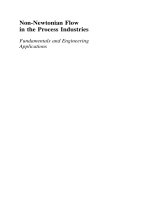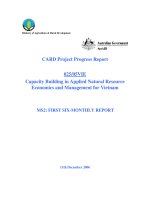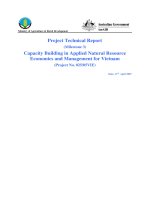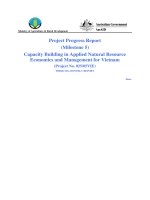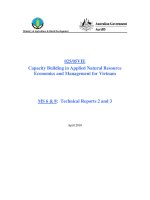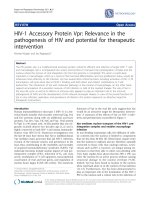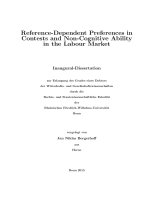NON COMPLIANCE CLAIMS IN THE WTO DISPUTE SETTLEMENT AND LESSONS FOR VIETNAM
Bạn đang xem bản rút gọn của tài liệu. Xem và tải ngay bản đầy đủ của tài liệu tại đây (822.03 KB, 77 trang )
MINISTRY OF EDUCATION AND TRAINING
FOREIGN TRADE UNIVERSITY
DISSERTATION
NON-COMPLIANCE CLAIMS IN THE WTO
DISPUTE SETTLEMENT AND LESSONS FOR
VIETNAM
Major: Master of International Trade Policies and Law
TO THAI NINH
Ha Noi - 2017
MINISTRY OF EDUCATION AND TRAINING
FOREIGN TRADE UNIVERSITY
DISSERTATION
NON-COMPLIANCE CLAIMS IN THE WTO
DISPUTE SETTLEMENT AND LESSONS FOR
VIETNAM
Major: Master of International Trade Policies and Law
Full name: To Thai Ninh
Supervisor: Ph.D. Nguyen Ngoc Ha
Ha Noi - 2017
TABLE OF CONTENTS
TABLE OF CONTENTS ............................................................................................... i
ACKNOWLEDGEMENT............................................................................................. 1
ABBREVIATIONS........................................................................................................ 2
INTRODUCTION ......................................................................................................... 1
1. Literature review ................................................................................................... 1
2. Objectives of the thesis ........................................................................................... 3
3. Research questions ................................................................................................. 4
4. Methodology ........................................................................................................... 4
5. Outline of the thesis................................................................................................ 4
CHAPTER 1: OVERVIEW OF NON-COMPLIANCE CLAIM IN THE WTO
DISPUTE SETTLEMENT SYSTEM ........................................................................... 6
I. Functions and principles of WTO Dispute Settlement System ............................ 6
1. WTO dispute settlement mechanism - Introduction ......................................... 6
2. Preserving the rights and obligations of WTO Members ................................. 8
3. Clarification of rights and obligations through interpretation ........................ 8
II. WTO DSU procedures and Compliance stage..................................................... 9
1. Consultation ...................................................................................................... 11
2. Good Offices, Conciliation and Mediation ...................................................... 13
3. Panel Procedures .............................................................................................. 14
4. Appellate Body Review (Appeal) ..................................................................... 19
5. Compliance stage: Remedies ............................................................................ 23
CHAPTER 2: NON-COMPLIANCE CLAIMS IN THE WTO DISPUTE
SETTLEMENT: SCRUNITY OF RETALIATION .................................................. 26
I. Introduction to WTO DSU Remedies .................................................................. 27
1. Comparison of Final Remedy’s and Temporary Remedies’ .......................... 28
2. Other Dilemmas Resulting from the Implementation of Retaliation ............. 30
II. The effectiveness of WTO Dispute Settlement System and the purpose of
Retaliation ................................................................................................................ 36
i
1. The Effectiveness of WTO Remedies ............................................................... 36
2. Retaliation and its purposes ............................................................................. 37
III. Options to improve remedies ............................................................................ 40
1. Retroactivity of remedies ................................................................................. 42
2. Compensation as a possible remedy option ..................................................... 44
3. Retaliation ......................................................................................................... 47
CHAPTER 3: PARTICIPANT OF VIETNAM TO WTO DISPUTE
SETTLEMENT SYSTEM AND LESSON FOR VIETNAM .................................... 53
I. Introduction to ongoing cases of Vietnam ........................................................... 53
1. Vietnam- United States: Anti-Dumping Measures on Certain Shrimp
from Viet Nam (DS404) ........................................................................................ 53
2. DS 429: United States - Anti-Dumping Measures on Certain Frozen
Warm water Shrimp from Viet Nam .................................................................. 55
3. DS496: Vietnam challenged Indonesia regarding a safeguard measure
on imports of certain flat-rolled iron or steel products ...................................... 56
II. Solutions for Vietnam ......................................................................................... 57
1. Capacity building through extended third party rights ................................. 58
2. Making cross-retaliation more readily available for Vietnam ....................... 59
3. Retaliation with the purpose of inducing a mutually agreeable solution –
Second and last best option for Vietnam ............................................................. 59
CONCLUSION ............................................................................................................ 64
REFERENCE LIST .................................................................................................... 66
ii
ACKNOWLEDGEMENT
I would like to express the sincerest thanks to my supervisor, Dr. Nguyen
Ngoc Ha, whose supervision, encouragement, and patience have given me the
confidence to expand my humble understanding of the subject into this 55page thesis. Without his excellent supports and instructions, I could never
complete this academic research work.
I would like to express my special thanks to Prof. Henry Gao, Prof.
Claudio Dordi, their lectures and valuable advice gave me the inspiration to
develop this subject into thesis. Also, this paper would not have been possible
without the valuable legal resources provided by Mr. Claudio Dordi and Mrs.
Pham Thi Van Thanh.
I am indebted to the Vietnam Competition Authority, and all of my
colleagues there for providing me the best facilities and professional
inspiration in the completion of the thesis. I would also like to thank my
teachers at the Faculty of Post-Graduation, Foreign Trade University of
Vietnam who helped me build up the knowledge and enthusiasm in the field of
international trade law.
Last but not least, I would like to express my deepest gratitude to my
family, who never stop supporting me throughout the way and offering me the
most serene place in the world.
Despite all the aforementioned, any errors in this paper remain my own.
ABBREVIATIONS
AB
Appellate Body
AD
Antidumping
ACWL
Advisory Centre on WTO Law
DOC
U.S Department of Commerce
EC
European Community
EU
European Union
DSB
Dispute Settlement Body
DSU
Understanding on Rules and Procedures Governing the
Settlement of Disputes
DSM
Dispute Settlement Mechanism
GATS
General Agreement on Trade in Services
GATT
General Agreement on Tariffs and Trade
LDCs
Least Developed Countries
NGO
Non-Governmental Organization
NME
Non-market Economy
POR
Period of review
TRIPS
Trade-Related Aspects of Intellectual Property Rights
US
United States
VCCI
Vietnam Chamber of Commerce and Industry
VASEP
Vietnam Association of Seafood Exporters and Producers
WTO
World Trade Organization
INTRODUCTION
1. Literature review
1.
Apart from many press articles, publications of organizations and
individuals about the perspective of developing countries in the WTO dispute
settlement system, since the participation of Vietnam into WTO, there are
some thesis, articles, research about the position of Vietnam in the system.
Such studies mainly focus on examining the challenges and opportunities that
Members face in dealing with compliance issues, the lesson learned mostly
from the theoretical aspects.
2.
The issue of compliance with WTO Dispute Settlement decisions has
been the focus of increasing attention by international trade experts. As such,
there are a number of articles in which such theme is specifically addressed.
Most articles, however, albeit excellent sources of information, appear to fall
short of offering a comprehensive analysis of the compliance issues facing the
WTO. Even more rare – possibly inexistent – is explicit reference to State
administration and enforcement in theories of compliance, a reflection of a
divide that appears to still persist between scholarship and practice.
3.
In any case, McGivern’s views are perhaps the most thorough analysis
of the issue of compliance1. In this article, McGivern explains the logic
behind retaliation as well as its pros and cons, identifies cases and examples
where there have been problems and propose different ways of achieving
remedies for non-compliance, examining different methods such as political
pressure, compensation or fines, carousel retaliation2, collective retaliation3
and punitive retaliation4. The author concludes by stating that the optimism of
some that retaliation would serve as a powerful tool of compliance was
mistaken and that the binding nature of dispute settlement decisions under the
umbrella of the WTO is no assurance of compliance as the systems has its
1
Brendan P. McGivern, page 144,145, “Seeking Compliance in WTO rulings: Theory, Practice and Alternatives”,
JSTOR, 2002
2
Carousel retaliation logic prescribes the rotation of products subject to sanctions.
3
Collective retaliation would allow all countries to retaliate the losing party.
4
Punitive retaliation prescribes punishing the losing party in more than just the level of nullification or impairment
sustained by the complaining party.
1
limitations5. Unfortunately, the author does not offer an opinion of which
course of action should be taken.
4.
The study of compliance with WTO DS decisions is one that runs in
parallel with the aforesaid ones. Nevertheless, there is a variety of studies on
retaliation, which is one of the facets of present work as well as a small
number of articles that approach the issue of compliance per se, one of which
is the yearly statistical of disputes brought before the WTO as below:
Table1: Evolution of the number of complaints brought before the WTO’s
DSM
Year Complaints
Year Complaints
1995
1996
1997
1998
1999
2000
2001
2002
2003
2004
2005
2006
2007
2008
2009
2010
2011
2012
2013
2014
2015
2016
25
39
50
41
30
34
23
37
26
19
11
20
13
19
14
17
8
27
20
14
13
13
Source: WTO DSB
5.
To the interest of the thesis at hand is the relation found between the
number of complaints brought into the DS mechanism and the number of
Article 22 of non-compliance, which, as previously explained, are formed
when there is disagreement over compliance with decisions and rulings of the
Dispute Settlement Body. The figures involving Article 22 until 2015 are as
in table below:
Table2: Number of Article 22 retaliation awards
Year
Case
5
1999
3
2000
2
2003
1
2004
9
2009
2
2013 2015
1
1
Source: WTO DSB
Brendan P. McGivern, “Seeking Compliance in WTO rulings”, JSTOR, 2002, p157
2
6.
These numbers and what they mean will be object of greater analysis at
a later stage of this work by analyzing non-compliance cases, it will be
possible to draw a conclusion on whether there is a problem with compliance
in the WTO, thus answering one of the research questions of this thesis. The
second question – if management is preferred to enforcement as to induce
compliance – of this thesis will be answered by analyzing official WTO
Dispute Settlement reports, case reviews and articles on retaliation and
compliance written by different authors. The third question to this thesis –
how to improve the compliance issues of Dispute Settlement mechanism –
will be drew out the lessons for Vietnam in its on-going cases.
2. Objectives of the thesis
7.
The WTO dispute settlement system is undoubtedly the most
successful and widely-used inter-governmental dispute settlement system in
the field of trade. The participation of developing countries in the WTO
Dispute Settlement is of great interest to many academic writers as lawyers,
economists, and political scientists. Among of them, the issue of noncompliance is also the most interesting topic are discussing as well as on the
table for the future of Dispute Settlement Mechanism of the WTO. This thesis
is not to propose changes in the DSM to resolve this gap of the WTO DSM. It
is focus on certain non-compliance cases to figure out the current problems of
the DSM of which have been taken the legal rights of certain Members,
particularly developing members. Vietnam is not an exception especially
when it is a new comer in this system and now having 3 on-going cases
within this auspice. Studying and drawing lessons from the specific WTO
dispute settlement cases to adjust its rules and regulations are necessary to be
able to adapt to this playground. The lack of implementing rules and
regulations cannot be used as an excuse. By examining the working
mechanism of the WTO Dispute Settlement, particularly compliance stage,
the last purpose of this thesis is to determine the most suitable strategy that
Vietnam should use in dealing with the WTO Dispute Settlement System.
This thesis provides the updated information on the participation Vietnam in
the WTO DSS. Ultimately, this thesis is intended not simply as an academic
3
exercise, but also as a practical policy tool.
3. Research questions
8.
Base on the above mentioned ambition, this thesis is intended to give
answers to the following research questions:
The problem is that neither the DSU nor the WTO treaty provisions
stipulate explicitly the purpose of retaliation?
-
Whether or not WTO retaliation is an effective instrument?
How does Vietnam participate in the WTO Dispute Settlement System
and challenging for its implementation stage?
Which strategies for Vietnam to be highest benefit from the WTO
Dispute Settlement System by using reasonable strategy in implementation
stage?
4. Methodology
9.
The thesis will use the following research methodologies: Firstly,
doctrinal research will be employed. This research will involve the summary,
collation, analysis and/or synthesis of existing research or documents. As a
result, the relevant regulations relating to the dispute settlement under the
WTO will be reviewed and analyzed. Relevant text books, articles, reports
will also be consulted. Finally, some comparative researches involving the
laws and experiences learn from WTO cases related to non-compliance issue
also addressed.
5. Outline of the thesis
10. The thesis is structured with three chapters:
11. The first chapter outlines the structure and operation of the WTO trade
dispute settlement system. The section shows the difference of WTO DSS in
comparison with the GATT Dispute Settlement System in the context of the
shortcomings of the previous GATT dispute settlement system and the
advantages of the WTO DSS. Chapter 2 also summarizes the key articles and
procedures of the DSU.
12. The second chapter will get into detailed analysis of certain main
4
problem of current dispute settlement system, non-compliance and how to
remedies this issues by addressing some specific cases. This chapter is the key
chapter to help find out the solution for Vietnam when it comes to its
implementation.
13. The third chapter will come out with certain solutions from the
analysis and how it should be applied for Vietnam’s cases.
5
CHAPTER 1: OVERVIEW OF NON-COMPLIANCE CLAIM IN THE
WTO DISPUTE SETTLEMENT SYSTEM
I. Functions and principles of WTO Dispute Settlement System
1. WTO dispute settlement mechanism - Introduction
15. The WTO dispute settlement mechanism is viewed as the original and
substantive agreement to maintain the tradeoff between the rights and
obligations of its Members, which are preserved under the WTO agreements.
The DSU functions as not only an adjudicatory system but also as a dispute
prevention mechanism. It is regarded as a central element in providing
security and predictability to the multilateral trading system.6 It acts to clarify
the existing provisions of those agreements in accordance with customary
rules of interpretation of public international law.7 The DSU contains a
constraint in terms of the judicial and diplomatic functions. Its features show
both a desire to combine different policies and approaches and some
compromise among negotiators.8 The objective of the WTO in establishing
the Dispute Settlement Mechanism is “to achieve a positive settlement of the
disputes between Member States.”9 Article 3.7 of the DSU provides that the
aim of the mechanism is to secure a positive solution for parties to a dispute.
16. The DSU either sets out procedures or seeks to identify the aims and
objects of the system as a whole. Under this mechanism, the procedure for
settling disputes, a dispute first goes through a bilateral consultation and then
upon the failure of the consultation, the complaining Member can request the
WTO DSB to establish a Panel. If other WTO Members have interest in the
case, they can join as ‘third parties’ before the Panel. The scope of objects of
the WTO disputes includes violation complaints, non-violation complaints,
and ‘situation’ complaints arising from agreements of the WTO10.
6
The DSU art 3.2.
Ibid.
8
Ibid.
9
Bryan. Mercurio & Yongjie Li (ed.), WTO Dispute Settlement Understanding: A detailed Interpretation, (Kluwer Law
International, 2005), at 24.
7
10
In accordance with Article XXIII.1 of GATT 1994, the complaints can be resolved under the WTO dispute settlement
mechanism including violation complaint, non-violation complaint, and ‘situation’ complaint. Violation claims arise
when a member state does not conduct its obligations under the provisions of the Agreement. Non-violation claim arises
6
17.
Article 3.2 of the DSU provides that the dispute settlement system of
the WTO is a central element in providing security and predictability to the
multilateral trading system. Accordingly, the DSU has the function to specify
and construe the rules and define the rights and obligations of the Members so
that they may abide by their commitments under an agreement11. The WTO
Secretariat stated that the WTO dispute settlement system12.
…plays an important role in clarifying and enforcing the legal
obligations contained in the WTO Agreements. While dispute
settlement is certainly not the only activity taking place within the
WTO, it has become an important part of the practical reality of the
Organization. WTO dispute settlement has also become an
important tool in the management by WTO Members of their
international economic relations at large.
18. It is noted that international trade in the WTO is the flow of goods and
services between Members and conducted by private sectors rather than
States themselves. These market participants require stability and
predictability in the governing legal instruments, which apply to their trading
operations.13 To satisfy the requirements of the participants, the DSU aims to
provide “a fast, efficient, dependable and rule-oriented system to resolve
disputes about the application of the provisions of the WTO Agreement.”14
The dispute settlement system serves to ensure that the trading system works
in a more secure and predictable manner by reinforcing the rule of law.15
19. It is obvious that the WTO agreements are not as workable as they
could be for all WTO Members if some of them fail to obey their obligations
committed under such agreements. Thus, an effective mechanism to settle
disputes helps to increase the practical value of the commitments, which the
when a country issued a trade measure which damage to the benefits of claim-nations obtaining from the Agreement or
impede the implementation of one of the objectives of the Agreement regardless the measures violate the Agreement or
not. In case of claims based on ‘the existence of a situation’, the national plaintiff must also prove the damage which they
suffer from or obstacles they may encounter in order to achieve objectives of the Agreement.
11
Guohua Yang, above n 11, at 16
12
A Handbook on the WTO Dispute Settlement System: A WTO Secretariat Publication prepared for publication by the
Legal Affairs Division and the Appellate Body (Cambridge University Press, 2004), at ix
13
Ibis, at 2.
14
Ibis.
15
Ibid.
7
signatories undertook in an international agreement.16 If the disputes are
resolved a timely and appropriate manner, it helps to avoid the adverse
impacts of international trade conflicts and to equalize the situation (‘levels
the playing field’) between stronger and weaker parties.
2. Preserving the rights and obligations of WTO Members
Article 3.2 of the DSU provides that:
…The Members recognize that it serves to preserve the rights and
obligations of Members under the covered agreement, and to
clarify the existing provisions of those agreements in accordance
with customary rules of interpretation of public international
law…
20. Certainly, the dispute settlement system provides a mechanism through
which WTO Members can ensure that “their rights under the WTO
Agreement can be enforced.”17 The system provides a forum for the
respondent to defend itself if it disagrees with the claims raised by the
complainant. Yet the mechanism serves to preserve the rights and obligations
of the Members and to clarify the existing provisions of WTO agreements, it
cannot add to or diminish the rights and obligations provided in the covered
agreements.18 Indeed, DSB’s recommendation or rulings aim at achieving a
satisfactory settlement of the matter in accordance with the rights and
obligations under the covered agreements.19
3. Clarification of rights and obligations through interpretation
21. It is recognized that legal provisions are often drafted in general terms
in order to be of common applicability and to cover a large number of
individual cases, not all of which can be explicitly regulated.20 Moreover,
legal provisions in international agreements frequently “lack clarity because
they are compromise formulations resulting from multilateral negotiations.”21
16
Ibid., at 1.
Ibid., at 3.
18
The DSU art 3.2.
19
Ibid., art 3.4.
20
A Handbook on the WTO Dispute Settlement System, at 3.
21
Ibis.
17
8
Practically, individual cases regularly need an interpretation of the relevant
provisions. As stated in the DSU, the dispute settlement system is aimed to
clarify the existing provisions of the WTO Agreement in accordance with
customary rules of interpretation of public international law.22
II. WTO DSU procedures and Compliance stage
22. The Dispute Settlement Understanding (DSU), formally known as the
Understanding on Rules and Procedures Governing the Settlement of
Disputes, establishes rules and procedures that manage various disputes
arising under the Covered Agreements of the Final Act of the Uruguay
Round. All WTO member nation-states are subject to it and are the only legal
entities that may bring and file cases to the WTO. The DSU created the
Dispute Settlement Body (DSB), consisting of all WTO members, which
administers dispute settlement procedures. It provides strict time frames for
the dispute settlement process and establishes an appeals system to
standardize the interpretation of specific clauses of the agreements. It also
provides for the automatic establishment of a panel and automatic adoption of
a panel report to prevent nations from stopping action by simply ignoring
complaints. Strengthened rules and procedures with strict time limits for the
dispute settlement process aim at providing “security and predictability to the
multilateral trading system” and achieving “a solution mutually acceptable to
the parties to a dispute and consistent with the covered agreements.” The
basic stages of dispute resolution covered in the understanding include
consultation, good offices, conciliation and mediation, a panel phase,
Appellate Body review, and remedies.
23. The WTO dispute settlement system sets up several rules and
procedures that have to be followed to secure compliance. Parties are required
first to request consultation when a dispute arises (consultation stage). If the
consultation fails, the complaining party may request the establishment of a
panel (adjudication stage). During this stage, if one of the parties is
dissatisfied with the panel‟s decision, it may appeal to the Appellate Body.
22
The DSU art 3.2.
9
The panel/Appellate Body will issue a report that the Dispute Settlement
Body (DSB) will adopt. After the adoption of the report, the DSB, a body for
supervising the implementation of the report(s), requests the losing party bring
itself into prompt compliance with WTO law or find mutually satisfactory
adjustments (implementation stage). If the losing party fails to bring its measure
into conformity within a reasonable period of time, the complaining party is
entitled to resort to a temporary measure, either compensation or the suspension
of the WTO obligations (retaliation) as the last resort (non-implementation
stage).
10
1. Consultation
24.
Traditionally, GATT attached significant importance to bilateral
consultation, and many disputes actually were settled in this manner. GATT
provides for some special consultation and review procedures, such as the one
mentioned in Article XIII at paragraph 2 (specifying that a contracting party
shall, upon request by another contracting party regarding fees or charges
connected with importation/exportation, review the operation of its laws and
11
regulations), as well as in the “1960 GATT decision on arrangements for
consultations on restrictive business practices” (specifying that a contracting
party shall, upon request by another contracting party regarding the business
practice by which international trade competitions would be limited, give
sympathetic consideration and provide an adequate opportunity for
consultation). However, paragraph 1 of Article XXII and paragraph 1 of
Article XXIII of GATT play the central role in prescribing that “formal”
consultation to take place prior to panel procedures.
1.1. Consultation under Article XXII and Article XXIII
25. Regarding the difference between the two provisions, consultation
under Article XXII covers any matter affecting the operation of GATT, while
the coverage of consultation under Article XXIII is limited to certain matters.
Specifically, Article XXIII provides that a contracting party may make
representations or proposals to another contracting party if the former party
considers that any benefit accruing to it directly or indirectly under GATT is
being nullified or impaired or that the attainment of any objective of GATT is
being impeded as the result of:
(a) the failure of another contracting party to carry out its obligations under
GATT;
(b) the application by another contracting party of any measure, whether or
not it conflicts with the provisions of GATT, or
(c) the existence of any other situation.
26. Thus, disputes over “nullification or impairment of any benefit
otherwise to accrue under GATT” may be brought to consultation under
Article XXIII. Another point of difference between the two concepts of
consultation is the participation of a third country; it is permitted only with
respect to consultations under Article XXII. Similar differences can be seen in
the relation between Article XXII and Article XXIII of GATS.
1.2. Consultation under Article 4 of DSU
27. The DSU specifies that it adheres to the principles of the management
of disputes applied under Articles XXII and XXIII of GATT (paragraph 1,
12
Article 3 of DSU). Article 4 of DSU provides for consultation procedures and
rules and specifies that each party should give sympathetic consideration to
any representations made by another party and should provide adequate
opportunity for consultation. It provides that the parties which enter into
consultations should attempt to obtain satisfactory adjustment of the matter
concerned.
28. According to the DSU (paragraph 4, Article 4), a request for
consultations shall be effective when such request is submitted in writing,
gives reasons for the request, including identification of the measures at issue
and an indication of the legal basis for the complaint and is notified to the
DSB (Dispute Settlement Body of WTO). It provides that the party to which a
request is made shall reply within 10 days after the date of its receipt and shall
enter into consultations in good faith within a period of no more than 30 days
after the date of receipt of the request, with a view to reaching a mutually
satisfactory solution (paragraph 3, Article 4 of DSU).
29. WTO Members other than the consulting parties are to be informed in
writing of requests for consultations, and any Member that has a substantial
trade interest in consultations may request to join in the consultations as a
third party. It is also provided that the party to which the request for
consultations is addressed may reject the said third party’s desire to join in the
consultations when the party considers that “the claim of substantial trade
interest is not well-founded” (paragraph 11, Article 4 of DSU).
2. Good Offices, Conciliation and Mediation
30. Unlike consultation in which a complainant has the power to force a
respondent to reply and consult or face a panel, good offices, conciliation and
mediation "are undertaken voluntarily if the parties to the dispute so agree.
No requirements on form, time, or procedure for them exist. Any party may
initiate or terminate them at any time. The complaining party may request the
formation of panel, if the parties to the dispute jointly consider that the good
offices, conciliation or mediation process has failed to settle the dispute. Thus
the DSU recognized that what was important was that the nations involved in
a dispute come to a workable understanding on how to proceed, and that
13
sometimes the formal WTO dispute resolution process would not be the best
way to find such an accord. Still, no nation could simply ignore its obligations
under international trade agreements without taking the risk that a WTO panel
would take note of its behavior.
3. Panel Procedures
If consultation, good offices, conciliation or mediation fails to settle the
dispute, the complaining party may request the formation of panel.
3.1. Panel establishment
31.
Paragraph 2, Article XXIII of GATT provides that if no satisfactory
adjustment is effected through consultations between the contracting parties
concerned, the dispute concerned may be referred to the DSB (Dispute
Settlement Body, or “Contracting Parties” under the former GATT) with
respect to alleged “nullification or impairment of any benefit otherwise to
accrue under GATT” as mentioned above.
32. In the past, such disputes referred to the Contracting Parties were
brought to a working group consisting of the disputing parties and neutral
parties. The working group was supposed to confirm claims of the respective
disputing parties and discuss them, but was not required to make a legal
judgment. The function of the working groups was limited to the facilitation
of negotiations and dispute settlement. Later, however, the “panel” procedure
was introduced and has become the regular practice. A panel is composed of
panelists who do not represent a government or any organization, but are
supposed to serve in their individual capacities. A panel is principally to make
a legal judgment regarding the matters in dispute. Also, the WTO dispute
settlement mechanism employs a two-tier appellate system, establishing the
Appellate Body. GATT provides that consultations pursuant to paragraph 1 of
its Article XXIII should precede the establishment of a panel in accordance
with paragraph 2 of Article XXIII, but it was generally accepted that a panel
could be established after consultations under Article XXII even if there had
been no consultation under Article XXIII.
33. The WTO dispute settlement mechanism does not differentiate
consultations under Article XXII from those under Article XXIII of GATT. If
14
consultations fail to settle a dispute within 60 days after the date of receipt of
a request for consultations, the complaining party may submit a written
request to the DSB for the establishment of a panel23. It is provided that such
written request should indicate whether consultations were held, identify the
specific measures at issue and provide a brief summary of the legal basis of
the complaint sufficient to present clearly the problem of inconsistency with
trade agreements in question24.
34. As a rule, decisions of the DSB are made by consensus, but the socalled “negative consensus method” is applied to the issues of “establishment
of panels”25, “adoption of reports of a panel or Appellate Body”26 and
“compensation and the suspension of concessions”27, the requested action is
approved unless all participating Member countries present at the DSB
meeting unanimously object. As far as the DSB’s establishment of a panel is
concerned, paragraph 2, Article 6 of DSU specifies that “a panel shall be
established at the latest at the DSB meeting following that at which the
request first appears as an item on the DSB’s agenda, unless at that meeting
the DSB decides by consensus not to establish a panel.”
35. Parties other than the complaining party which requested the
establishment of a panel are entitled to block the panel establishment but only
once28. This veto is most frequently employed by the respondent. Therefore,
in most cases, a panel is established at the second DSB meeting at which the
request appears as an item on the DSB’s agenda. Any Member that desires to
be joined in the panel procedure as a third party because of having a
substantial interest in the matter concerned is required to express such desire
at the time of the establishment of a panel or within 10 days after the date of
the panel establishment.
3.2. Panel composition
36.
Once a panel is established, the next step is to select panelists.
23
The DSU art 4, para 7
Ibis, art 4, para 2
25
Ibis, art 6, para 1
26
Ibis, art 16, para 4 and art 17 para 14
27
Ibis, art 22, para 6
28
Ibis, art 6, para 1
24
15
Selection of panelists is conducted through proposals by the WTO Secretariat
on panelists29. Generally, the Secretariat summons the disputing parties and
hears their opinions concerning desirable criteria for selecting panelists, such
as home country, work experience and expertise. Then, the Secretariat
prepares a list of nominees (indicative panelist, normally insist of 6 qualifying
persons) providing their names and brief personal record, and show the list to
both parties. It is provided that citizens of the disputing parties or third parties
joined in the panel procedure may not serve on a panel concerned with that
dispute, unless the parties to the dispute agree otherwise30.
37. It is also provided that either disputing party “shall not oppose
nominations except for compelling reasons”31. However, since the definition
of a compelling reason is not very strict, frequently nominations made by the
WTO Secretariat are not accepted by either party, and sometimes this happens
several times. Also, it is provided that if there is no agreement on the panelists
within 20 days after the date of the establishment of a panel, the DirectorGeneral, upon request of either party, shall determine the composition of the
panel after consulting with the parties to the dispute32.
3.3. Written submissions
38. After the composition of a panel is determined, the panel meets to
determine the timetable for the panel process and the working procedures it
will follow throughout the dispute. Then, after three to six weeks from the
establishment of the panel, the complainant provides the panel a written
submission containing all facts relating to the issue concerned and its claims.
The respondent also provides a written submission to the panel in two to three
weeks after the receipt of the complainant’s written submission33. Although
there is no rule specifying the composition of a written submission, in many
cases they are composed of five parts: 1) introduction; 2) facts behind the
complaint; 3) procedural points at issue; 4) claims based on legal grounds;
and 5) conclusion.
29
Ibis, art 8, para 6
Ibis, para 3
31
Ibis, para 7
32
Ibis
33
The DSU, appendix 3, para 12
30
16
39.
Regarding the disclosure of the written submissions, it is provided that
“deliberations of a panel and documents submitted to it shall be kept
confidential. Nothing in the DSU shall preclude a party to a dispute from
disclosing statements of its own positions to the public.”34 Thus, disputing
parties may disclose their own written submissions to the public. Actually, the
United States and EU disclose many of their written submissions to the
public.
3.4. Panel meetings
40. A panel generally meets two times. Meetings of a panel are held in the
WTO building, instead of a special facility such as a court. Traditionally, a
panel meets in closed session, just like other meetings of WTO. Generally,
panel meetings last one to three days.
41. The first meeting of a panel is supposed to be held in one to two weeks
after the receipt of the written submission submitted by the respondent35. This
first substantive meeting is to begin with a briefing made by the chairman of
the panel on how to proceed with the meeting. Then, the complainant and the
respondent, respectively, give oral statements regarding their own written
submissions. This is followed by questioning by the panel and in some cases a
question-and-answer session between the disputing parties. Next, a third party
session is held, where oral statements and a question-and-answer session
occurs. As a rule, the presence of third parties is permitted only at these third
party sessions, and third parties may not be present at substantive meetings.
42. The second substantive meeting of a panel is supposed to be held after
two to three months since the first substantive meeting. The second meeting
focuses mainly on counter-arguments against claims of the other party made
during the first substantive meeting. Unlike the first substantive meeting, third
parties are not permitted to attend the second substantive meeting. Unless
otherwise agreed between the disputing parties, third parties may not make
written submissions or obtain written submissions submitted by the disputing
parties.
34
35
Ibis, para 3
The DSU, appendix 3, para 12
17
3.5. Panel Reports
Following the second substantive meeting, the panel issues an interim report
to the disputing parties. The interim report describes the findings and
conclusions of the panel. An interim report provides the first opportunity for
disputing parties to tell whether their arguments are supported by the panel or
not. Disputing parties are entitled to submit comments or submit a request for
the panel to review and correct technical aspects of the interim report for
correction.
43. The DSU provides that the period in which the panel conducts its
examination, from the date that the composition and terms of reference of the
panel have been agreed upon until the date the final report is issued to the
disputing parties, “shall not exceed six months as a general rule.”36 When the
panel considers that it cannot issue its report within six months, it is supposed
to inform the DSB in writing of the reasons for the delay together with an
estimate of the period within which it will issue its report37. The recent trend
is that cases requiring an examination period exceeding six months are
increasing because of the difficulty in confirming facts due to the existence of
a highly technical matter or difficult interpretations of a legal matter at issue.
Generally, a final panel report is issued shortly after the disputing parties
comment on the interim report, first to disputing parties and then to all
Members in the three official languages of the WTO (English, French and
Spanish).
44. A panel report contains, in its conclusion, the judgment reached by the
panel as well as recommendations regarding correction of the measures in
question. This conclusion is referred to the DSB, where the “negative
consensus method” is applied for the adoption of the panel report. The DSB
adopts the “recommendation and rulings”, which are legally binding the
parties concerned. Adoption of a panel report is supposed to be completed
between 21 and 60 days after the date the report has been circulated to the
36
37
The DSU, art 12, para 9
Ibis
18
Members38.
4. Appellate Body Review (Appeal)
4.1. Appeal to Appellate Body
45. If there is an objection to a panel report, disputing parties may request
the Appellate Body to examine the appropriateness of the legal interpretations
employed by the panel39. The Appellate Body is a standing group composed
of seven persons of recognized authority with demonstrated expertise in law,
international trade and the subject matter of the covered agreements
generally; the Appellate Body membership is broadly representative of
membership in the WTO.
Three persons out of the seven Appellate Body members are to serve on any
one case. Persons serving on the Appellate Body are selected by a consensus
of all Members at the DSB and serve for a four-year term. Each person may
be reappointed once40.
46. A Notice of Appeal should be filed no later than the DSB meeting at
which a panel report is scheduled to be adopted. Since it is provided that the
adoption of a panel report should be completed within 60 days after the date
of circulation of the panel report to the Members, an appeal is supposed to be
made within 60 days after the date of circulation41.
47. It is provided that an appeal should be limited to issues of law covered
in the panel report and legal interpretations developed by the panel. In
principle, factual findings of a panel may not be challenged42. Regarding legal
interpretations and findings, there is a precedent that mentions: “To determine
whether a certain incident occurred at a certain place/time is a matter of fact
typically. However, to determine whether a certain fact or a series of facts
complies with any given rule of a certain convention is a matter of law and
requires legal interpretation.”43
48.
After the filing of a Notice of Appeal, the Appellate Body shows the
38
The DSU, art 16, paras 1 and 4
Ibis, art 17, para 4
40
Ibis, para 2
41
The DSU, art 16, para 4
42
Ibis, art 17, para 6
43
EC-Hormone-Treated Beef Case (DS26)
39
19

